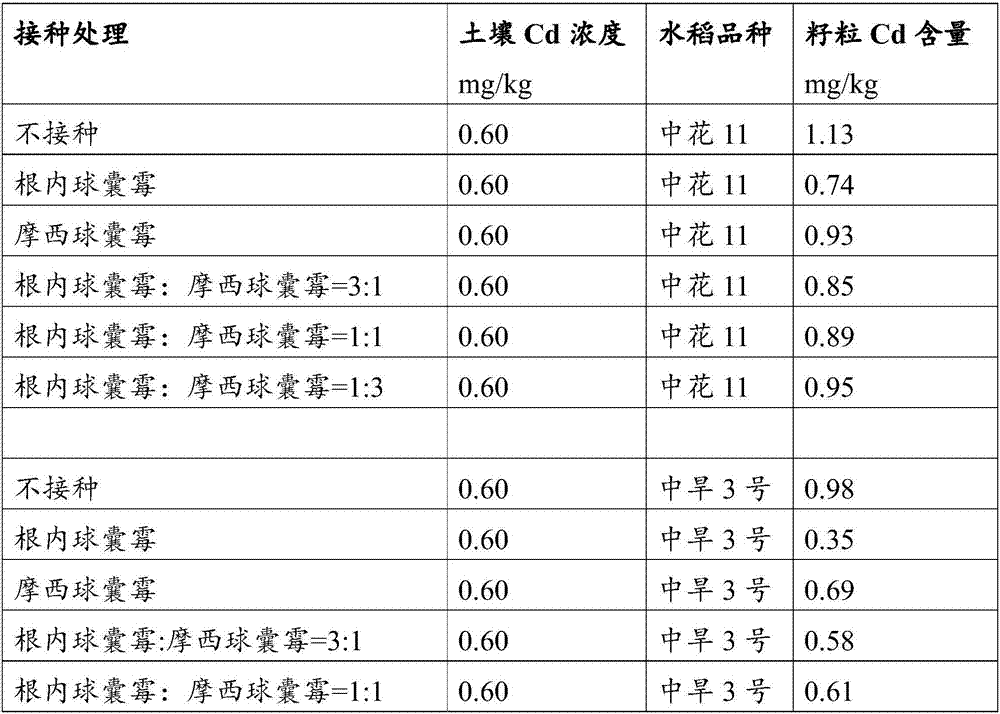Method capable of reducing content of heavy metal cadmium in rice grains
A technology of rice grains and heavy metals, which is applied in the field of agricultural environment, can solve the problems affecting the growth of crops in the soil environment, and achieve the effect of reducing the heavy metal cadmium content of rice grains and promoting nutrient absorption
- Summary
- Abstract
- Description
- Claims
- Application Information
AI Technical Summary
Problems solved by technology
Method used
Image
Examples
Embodiment 1
[0054] In order to screen the arbuscular mycorrhizal fungi that can reduce the heavy metal cadmium content in rice grains, in this example, G. intraradicularis and / or G. mosei were used to grow in places with low cadmium pollution (the final soil cadmium content was 0.60 mg / kg). , and two rice varieties, Zhonghua 11 and Zhonghan 3, were used.
[0055] The specific method is:
[0056] (1) Inoculum treatment of planting substrates
[0057] The planting substrate used was low-cadmium-contaminated farmland soil with a soil cadmium content of 0.60 mg / kg, and the experimental group was inoculated with G. rhizogenes and / or G. moses for inoculum treatment (see Table 1). The total spore density of the arbuscular mycorrhizal fungi in the substrate is 2000 spores per liter of substrate (the inventor found through preliminary tests that the AMF spore density after inoculation is higher than 500 spores per liter of substrate, preferably between 500-10000 spores / liter of substrate, optima...
Embodiment 2
[0072] The present embodiment describes a method for utilizing arbuscular mycorrhizal fungi to reduce the content of heavy metal cadmium in rice grains, and the specific method is as follows:
[0073] (1) Inoculant treatment of planting substrate and heavy metal cadmium treatment
[0074] The planting substrate used was a mixed substrate of air-dried water soil, river sand and vermiculite, and the volume ratio of soil, river sand and vermiculite was 2:1:1. Sterilize the planting medium. After mixing the sterilized planting substrate, add cadmium-containing solution, the concentration of cadmium is 0.6mg / kg, and the additive is CdCl 2 ·2.5H 2 O, the total cadmium concentration of the substrate background is 0.75mg / kg, so the total cadmium concentration of the final planting substrate is about 1.35mg / kg, which is slightly higher than the secondary standard agricultural land in the Chinese soil environmental quality standard (GB 15618-2008). pH>7.5) The standard of cadmium con...
Embodiment 3
[0096] The only difference between Example 3 and Example 2 is that Example 3 does not sterilize the planting substrate. The test results are shown in Table 3.
[0097] Table 3. Cadmium content (mg / kg dry weight) in the glumes and grains of Han No. 3 rice
[0098]
PUM
 Login to View More
Login to View More Abstract
Description
Claims
Application Information
 Login to View More
Login to View More - R&D
- Intellectual Property
- Life Sciences
- Materials
- Tech Scout
- Unparalleled Data Quality
- Higher Quality Content
- 60% Fewer Hallucinations
Browse by: Latest US Patents, China's latest patents, Technical Efficacy Thesaurus, Application Domain, Technology Topic, Popular Technical Reports.
© 2025 PatSnap. All rights reserved.Legal|Privacy policy|Modern Slavery Act Transparency Statement|Sitemap|About US| Contact US: help@patsnap.com



